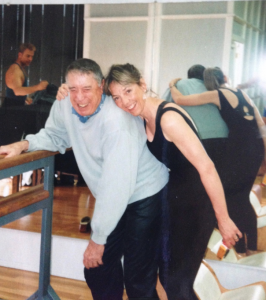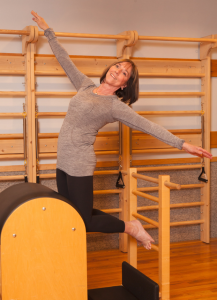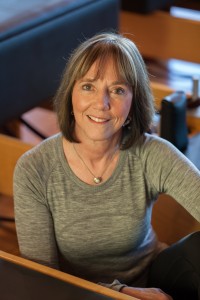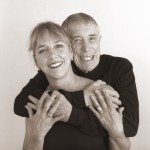Nov 14, 2018
Finding My Breath
by Pat Guyton
“Breathing is the first act of life and the last. Our very life depends on it. Since we cannot live without breathing, it is tragically deplorable to contemplate the millions and millions who have never mastered the art of correct breathing.” – Joseph Pilates
The principle of breathing is one of the reasons that Pilates provides comprehensive movement education. Breathing can be difficult to teach and to motivate client participation. How can something that is so natural be so difficult? Ron Fletcher said that Joe told him, “you got to OUT de air to IN de air”. Ron thought this was rather vague for doing or teaching. Percussive Breathing was his attempt to get people to breathe fully.
Ron Fletcher’s audible breathing is unique. He had been a dancer and performing artist. Dancers are body conscious and Ron did not want to see a “belly hanging out”. The chest was open to show presence and to project feeling. Therefore, the dancer would breathe by using the bucket handle and the pump handle rib motion. The natural movement of the diaphragm downward and upward was restricted to hold the stomach in. Many dancers would learn to control and impede the diaphragm by pulling upward with resulting tension and loss of natural organ movement.
Dance education has changed to include functional anatomy. This was not true at the time when Ron Fletcher studied with Martha Graham. He was exhorted to perform the contraction which he described as a fist into the solar plexus. Imagine feeling that fist as you take a deep inhalation. What does that do to your diaphragm? This is not true for just dancers. A runner told me that if she were to allow her belly to show, she could lose her sponsor endorsement because she would look fat. I was a dancer and I sucked that belly in for a long time!

My personal journey with breathing started when I had a car accident and I was told by therapists that I did not breathe. An osteopathic doctor explained that they observe breathing mechanics when making assessments. I was told that I was “stuck on the exhalation phase of breathing”, which means I was holding the diaphragm upward on both phases of respiration. When I met Ron, I studied his work. At last I felt that I had an answer to the mystery of breath. After many years, I became his assistant. I taught his breathing. He never corrected me and I assumed that I was on the path. After I left his study, I was again told that I did not know how to breathe. It took me two years to begin to learn a more functional approach. But I was in for another challenge.
In 2009, I was teaching my own workshops. I began to experience intermittent stomach pains which would resolve within a few hours. This pain did not seem to be coming from the area near my appendix (not getting the correct pain signals proved to be a serious problem!). I was in Singapore and the pain was of greater intensity, duration and constant. On the long flight, I was drinking only water and sleeping. I arrived home and went to an emergency room where I was misdiagnosed with a stomach ulcer. My husband was worried at my listlessness and took me to my doctor who ran me on a gurney to the MRI with a subsequent bowel resection. I lost my cecum and part of the small and large intestine. My appendix had been leaking, the surrounding tissue necrotic and I was in septic shock. This was dangerous and I endured four consecutive surgeries.
 A month prior to this emergency, I had enrolled in the Franklin Method Teacher Training. Eric Franklin included functional movement of the ribs and spine in breathing. The movement of the lungs and diaphragm was fascinating to me. I started adding this to my work but the old habits were hard to break. After surgery, the patient is placed in a chair to assist with recovery. Vital signs are monitored including the ability to breathe after being on a ventilator for six hours. I observed the nurses and surgeon watching to see if I was recovering from anesthesia. They told me to breathe deeply. I began to talk about how the diaphragm moves downward and the lungs lengthen and spiral around into the costo-diaphramatic recess. Yes, these were my words! The nurses were concerned that I was hallucinating. The surgeon smiled and said that I was awake. I continued to imagine the action of the lungs, diaphragm and airflow while I was hospitalized. This crisis taught me to “In de Air” and “Out de Air”.
A month prior to this emergency, I had enrolled in the Franklin Method Teacher Training. Eric Franklin included functional movement of the ribs and spine in breathing. The movement of the lungs and diaphragm was fascinating to me. I started adding this to my work but the old habits were hard to break. After surgery, the patient is placed in a chair to assist with recovery. Vital signs are monitored including the ability to breathe after being on a ventilator for six hours. I observed the nurses and surgeon watching to see if I was recovering from anesthesia. They told me to breathe deeply. I began to talk about how the diaphragm moves downward and the lungs lengthen and spiral around into the costo-diaphramatic recess. Yes, these were my words! The nurses were concerned that I was hallucinating. The surgeon smiled and said that I was awake. I continued to imagine the action of the lungs, diaphragm and airflow while I was hospitalized. This crisis taught me to “In de Air” and “Out de Air”.
I learned that breathing is natural if the cues and the images support function. Trauma, illness, and faulty movement cueing are things that can interfere with function. I was determined to improve my breathing. Another motivation was to assist the organs to find a new homeostasis within the body. The surgery created a temporary empty space and the organs would adjust by moving into a new relationship within the body. Reduction of scar tissue using deep breathing while healing was another motivator.
The Breathing on the Cadillac had new meaning. The inversion creates the opposite relationship to gravity. I would imagine the diaphragm moving downward against gravity on inhalation which is really upward in the plank. The organs move toward the pelvic floor. I called this “weight lifting for the diaphragm”. On exhalation, the organs moved upward inside the body aided by gravity. On Spine Twist, I used Joe’s image of wringing out all of the air. I think of wringing the towel to move the ribcage around the central axis. Clara Pilates said the air is the gasoline in the tank. On Double Leg Stretch, I pause on the full stretch to take the time to fill the tank before fully wringing out the air on the return.
As a teacher, I include breathing and organ cues within an exercise for total body awareness. The vitality of the physical body, emotional health and the mind require breathing. Our Pilates practice encourages natural adaption of breath quality for all activity.
Teaching suggestions for success:
- Image of the lungs spiraling in three dimensions inside the ribcage.
- Enjoy the diaphragm movement and notice the increased resilience of the ribs.
- Experiment with different breathing patterns to find what feels best for you.
- Experience the purpose of the exercise from the inside to the outside. Take time to feel it.
- Relax. Forced breathing is tension.
- Practice and be patient.

Pat Guyton has been teaching Pilates for over 33 years. She began her movement career as a modern dancer and later was a gymnastic choreographer and USGF sanctioned coach. Pat discovered Pilates in 1984 and began her mentorship.
Pat was privileged to have taken workshops with First Generation Teachers: Kathy Grant, Lolita San Miguel, Mary Bowen, Bruce King and Ron Fletcher. This experience has provided a view of the diversity of the lineages and the value that each of these teachers contributed to the evolution of the Pilates Method.
Pat studied with Ron Fletcher in depth. In 1995, she met and mentored with him by traveling to his workshops. Ron granted Pat permission to codify his work in 1998 and she served as his assistant at workshops. In 2000 he awarded her a Master Teacher Certificate of Merit of The Ron Fletcher Work.
Ron Fletcher was improvisational in his teaching. He was able analyze what the class needed within the first few minutes. He developed his unique style and additions of elements to his teaching. Those who traveled with him were able to see him choreograph and refine a new moment in the moment. This environment has informed Pat to be open to see what a client or class needs and to adapt for the individual.
Pat lives in Boulder was employed at Boulder Osteopathic Center as a registered physical medicine assistant in Colorado for ten years. This position offered her the opportunity to work with a variety of patients who needed exercise programs tailored for individual rehabilitation. The experience also fostered the coordination of Pilates with other health care professionals for the benefit of the client or patient. She has presented Pilates at numerous medical conferences.
Pat is the founder and owner of Pat Guyton Pilates Conservatory®, which offers mentorship programs, continuing education and a comprehensive teacher training program and she has a fully equipped studio in Boulder, CO.
Pat is a Franklin Method® Educator, Level III. Her style of teaching emphasizes functional anatomy and imagery to provide a safe and healthy exercise environment. Her clients range from those who are recovering from injury, people of all ages who seek increased health and vitality, and professional athletes.
Pat is a PMA Certified Pilates Teacher and a PMA CEC Provider. She has served on the Pilates Method Alliance Board of Directors from 2002 – 2008. She teaches Pilates workshops and Franklin Method® workshops nationally and internationally. Pat is a Distinguished Teacher for Pilates Anytime. Pat has authored Stretch Out Strap Shoulder Girdle and Arm Work.
Pat has a mission. Legacy is the generous communication of information for the next generation of Pilates teachers. The purpose is to develop the teacher in each who share the passion for Pilates. Through this next generation, the work will be passed to all who study to promote health and vitality. Teaching is a service to others.

